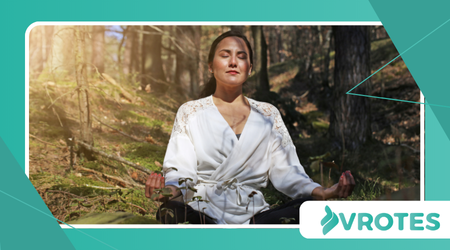Forest Bathing: Natural Stress Relief for Hormonal Imbalance

In our fast-paced modern world, forest bathing is essential. Where the demands of daily life often leave us feeling permanently drained, finding a sanctuary for restoration has become more crucial than ever.
For many, the relentless pace manifests as a disquieting dance of hormonal imbalances, impacting everything from mood and sleep to energy and overall well-being.
But what if the answer wasn’t a new supplement or an intricate diet, but something far more elemental and accessible?
Unplugging to Reconnect: The Essence of Shinrin-Yoku
The ancient Japanese practice of “Shinrin-Yoku,” or forest bathing, offers a profound antidote to this modern malady.
It’s not about hiking or intense exercise, but rather a mindful immersion in the atmosphere of the forest.
This deliberate slowing down allows our senses to awaken, absorbing the sights, sounds, smells, and even the subtle touch of nature.
Think of it as a reset button for your nervous system, a gentle recalibration.
The Symphony of Stress: How Hormones Go Awry
Our bodies are intricate chemical factories, with hormones acting as crucial messengers. When stress becomes chronic, the delicate balance of these messengers is disrupted.
Cortisol, often dubbed the “stress hormone,” goes into overdrive, leading to a cascade of unwelcome effects.
This sustained elevation can suppress other vital hormones, including those involved in sleep, mood regulation, and even reproductive health.
The result is often a feeling of being constantly on edge, tired yet wired.

Beyond the Green Canopy: Phytoncides and Their Potent Power
The magic of the forest extends beyond its visual appeal. Trees release aromatic organic compounds called phytoncides.
These natural chemicals, part of the trees’ defense system, are inhaled by us during forest bathing.
Remarkably, research suggests these compounds can significantly boost our natural killer (NK) cell activity, which plays a vital role in our immune system.
This innate boost helps our bodies combat stress at a cellular level, calming the inflammatory responses that can exacerbate hormonal issues.
A Calming Cascade: Lowering Cortisol Naturally
One of the most compelling benefits of spending time in nature is its direct impact on cortisol levels.
Studies have consistently shown a measurable decrease in this stress hormone after periods of forest immersion.
This isn’t just anecdotal; it’s a physiological response to a more serene environment.
When cortisol naturally lowers, our body can begin to restore equilibrium, allowing other hormones to function optimally.
This rebalancing act is crucial for overall health.
Sleep’s Sweet Embrace: Regulating Melatonin
Hormonal imbalance often disrupts sleep patterns, leading to a vicious cycle of fatigue and increased stress.
The gentle rhythm of the forest, the absence of artificial light and noise, helps to reset our circadian rhythm.
Read more: Self-Massage Techniques for Menopausal Headaches
By synchronizing our internal clock with nature’s cycle, forest bathing can promote the natural production of melatonin, the sleep-regulating hormone.
A good night’s sleep, in turn, is foundational for hormonal health and overall well-being.
Mood’s Mellow Tune: Serotonin and Dopamine Boost (forest bathing)
Beyond the purely physical, the emotional impact of nature is profound.
Spending time in the forest has been linked to increased levels of serotonin and dopamine, neurotransmitters vital for mood regulation and feelings of happiness.
This natural lift can counteract the irritability and low mood often associated with hormonal fluctuations. It’s an accessible and enjoyable way to nurture our mental landscape.

Bridging the Gap: Inflammation and Hormonal Health
Chronic inflammation is a silent aggressor, often lurking beneath the surface of many health issues, including hormonal imbalances.
The calming effect of the forest, coupled with the immunomodulatory effects of phytoncides, can help reduce systemic inflammation.
By mitigating this underlying stressor, the body is better equipped to manage its delicate hormonal ecosystem. It’s a holistic approach to wellness.
++ Herbal Tonics to Balance Hormones: Evidence-Based Recipes for Holistic Wellness
The Art of Mindful Immersion: Practical Steps for Your Journey (forest bathing)
Embracing forest bathing doesn’t require a remote wilderness. Even urban parks with a good tree canopy can offer benefits.
The key is intention. Leave your phone behind, or at least silence it. Engage all your senses.
Notice the texture of the bark, the scent of damp earth, the rustle of leaves, the interplay of light and shadow.
Walk slowly, breathe deeply, and allow yourself to simply “be” in nature.
An Illustrative Example: Sarah’s Journey to Balance
Consider Sarah, a 42-year-old marketing executive battling chronic fatigue and erratic menstrual cycles, hallmarks of hormonal disruption.
She felt perpetually wired and found it difficult to unwind. Traditional approaches offered limited relief. Intrigued by the concept, Sarah began incorporating weekly forest bathing sessions into her routine, spending an hour in a nearby park, mindfully observing the trees and listening to the birdsong.
Read here: How to Build a Daily Self‑Compassion Routine
After a few months, she noticed a remarkable shift: her sleep improved significantly, her energy levels stabilized, and her cycles became more regular.
Her body was finally finding its rhythm.
Another Perspective: Mark’s Path to Resilience
Or take Mark, a 55-year-old small business owner experiencing heightened anxiety and difficulty concentrating, classic signs of adrenal fatigue and hormonal stress.
He felt perpetually overwhelmed.
Driven by a friend’s recommendation, Mark started taking his morning coffee to a quiet, treed area near his office, dedicating twenty minutes to simply observing the natural world around him before his workday began.
This consistent, small dose of nature began to shift his perspective.
He reported feeling less agitated, more focused, and better equipped to handle daily pressures.
The gentle ritual became a cornerstone of his resilience.
The Wisdom of the Ages: A Timeless Remedy
For centuries, indigenous cultures have intuitively understood the healing power of nature.
Modern science is now catching up, providing empirical evidence for what our ancestors knew all along. It’s a testament to the enduring wisdom embedded within the natural world, a wisdom we can all tap into.
A Glimpse into the Data: The Power of Green Spaces
A noteworthy study published in Environmental Health Perspectives in 2016, “Urban Green Space and Stress Reduction:
A Systematic Review and Meta-Analysis,” analyzed numerous studies and concluded that exposure to green spaces is associated with significant reductions in physiological and psychological stress indicators.
This meta-analysis provides robust evidence supporting the calming and restorative effects of nature, further underscoring the benefits of forest bathing.
Forest bathing: A Holistic View
To better illustrate the multifaceted benefits, consider this simplified comparison:
| Approach | Primary Focus | Potential Mechanism for Hormonal Balance |
| Forest Bathing | Mindful immersion in nature | Reduces cortisol, boosts NK cells, improves sleep (melatonin), enhances mood (serotonin/dopamine), lowers inflammation. |
| Pharmacological | Symptom management via medication | Directly alters hormone levels or addresses specific symptoms (e.g., antidepressants, hormone replacement therapy). |
| Dietary Interventions | Nutritional intake | Provides nutrients for hormone synthesis, reduces inflammation through food choices, balances blood sugar. |
While each approach has its place, forest bathing offers a unique, non-invasive, and deeply restorative pathway to hormonal harmony.
The Ripple Effect: Beyond Personal Well-being
The benefits of connecting with nature extend beyond individual well-being.
When we cultivate a deeper appreciation for the natural world, we are more likely to protect it.
This symbiotic relationship between human health and environmental health is undeniable.
Our healing is intertwined with the healing of the planet.
Cultivating Consistency: Making Nature a Habit
Like any beneficial practice, consistency is key. Even short, regular doses of forest bathing can yield significant results.
Start with 15-20 minutes a few times a week and gradually increase your time as you feel comfortable.
The goal is to integrate nature into the fabric of your daily life, making it a non-negotiable part of your self-care routine.
It’s a small investment with profound returns.
Forest Bathing Reflecting Our Inner State
Think of your hormones as a complex ecosystem within you, constantly striving for balance.
When external pressures become too great, this ecosystem falters, much like a forest facing prolonged drought.
Forest bathing acts like a gentle, restorative rain, nourishing and revitalizing that inner landscape, allowing it to flourish once more. It’s a reminder that true healing often lies in simplicity.
Beyond the Buzzwords: An Authentic Connection
In an age saturated with quick fixes and fleeting trends, forest bathing stands as a timeless and authentic practice.
It doesn’t promise instant miracles, but rather a gentle, sustained path toward greater equilibrium.
It’s about remembering our innate connection to the natural world, a connection that can be profoundly healing for our bodies and minds.
Is there anything more fundamental than returning to our roots for true restoration?
Embracing Nature’s Healing Power (forest bathing)
The quest for hormonal balance can often feel overwhelming, yet the solution might be simpler than we imagine.
By mindfully immersing ourselves in the serene embrace of the forest, we tap into an ancient wisdom and a powerful natural pharmacy.
Forest bathing offers a profound and accessible pathway to reduce stress, regulate hormones, and reclaim our vitality.
It’s an invitation to slow down, breathe deeply, and allow nature to work its gentle, restorative magic. Make time for the trees; your hormones will thank you.
FAQ:
Q1: Do I need to go to a dense forest to practice forest bathing?
Not necessarily. While dense forests offer a deeper immersion, you can practice forest bathing in urban parks with trees, botanical gardens, or any green space where you can feel connected to nature.
The important thing is your intention and mindfulness.
Q2: How long should I spend in a forest bathing session to see results?
Even 15 to 20 minutes of mindful immersion can bring benefits. For more significant results, many people aim for 1 to 2-hour sessions.
Consistency is key, so incorporate the practice regularly into your routine.
Q3: Is forest bathing an intense physical activity?
No, forest bathing is not about intense exercise. It’s about walking slowly, sitting, observing, and interacting with the natural environment in a contemplative way.
The goal is to relax and reduce stress, not to burn calories.
Q4: Can I bring my cell phone or other electronic devices?
To maximize the benefits, it’s recommended to put your phone on airplane mode or, ideally, leave it at home. The idea is to disconnect from the digital world and reconnect with nature, minimizing distractions.
Q5: Who can benefit from forest bathing?
Practically anyone can benefit. It is especially helpful for those suffering from chronic stress, anxiety, insomnia, and hormonal imbalances.
It’s a safe and accessible practice for all ages and fitness levels.
++ Stressed? Try forest bathing or Shinrin-Yoku—a Japanese technique to relax your mind
